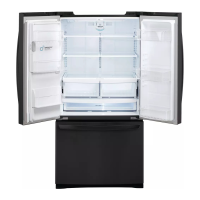Why is my LG Refrigerator icemaker making too much ice?
- MMichael UnderwoodSep 9, 2025
If your LG Refrigerator icemaker is making too much ice, the icemaker shutoff (arm/sensor) may be obstructed. Empty the ice bin to resolve this.

Why is my LG Refrigerator icemaker making too much ice?
If your LG Refrigerator icemaker is making too much ice, the icemaker shutoff (arm/sensor) may be obstructed. Empty the ice bin to resolve this.
Why are the lights not working in my LG LFX28968SB?
The refrigerator compartment lamp is LED interior lighting, and service should be performed by a qualified technician.
Why does my LG LFX28968SB have moisture inside?
Interior moisture buildup in your LG Refrigerator can occur if the doors are opened often or for long periods. Reduce the frequency and duration of door openings. High humidity can contribute, so maintain a reasonable humidity level in your home. Ensure food is correctly packaged by wiping containers dry and storing food in sealed packaging to prevent condensation and frost.
What causes frost on food in my LG LFX28968SB?
Frost or ice crystals forming on frozen food in your LG Refrigerator can be caused by opening the door frequently or for long periods of time. To lessen this effect, reduce the frequency and duration of door openings.
Why does my LG LFX28968SB Refrigerator have an odor?
If your LG Refrigerator has an unusual odor, the Air Filter may need to be set to the MAX setting or replaced. Set the Air Filter to the MAX setting.
| Type | freestanding |
|---|---|
| Color | black |
| Refrigerator Capacity | 27.6 cubic feet |
| Freezer Capacity | 8.9 cubic feet |
| Humidity Controlled Crispers | yes |
| Quick Freeze | no |
| Number of Refrigerator Door Bins | yes |
| Temperature Control | digital |
| Interior Light | led |
| Ice Maker | yes |
| Door Alarm | yes |
| Annual Energy Consumption | 528 kilowatt hours |
| Voltage | 120 volts |
| Depth | 35.375 inches |
|---|
Describes the dispenser's water and ice functions.
Explains the alarm that sounds for open refrigerator doors.
Details humidity control features for vegetable freshness.
Describes a special storage compartment for temperature-sensitive items.
Explains the feature for increased ice production capabilities.
Defines hazard symbols, signal words, and core safety rules for appliance use.
Covers detailed safety for power, installation, usage, and disposal procedures.
Identifies external parts like the LED display, dispenser, and handles.
Details internal parts like shelves, lamps, ice system, and drawers.
Covers unpacking, location choice, flooring, temperature, and clearances.
Procedures for removing and assembling doors, drawers, and handles.
Details connecting the water supply and required water pressure.
Steps for powering on, leveling, and aligning the refrigerator doors.
Covers cleaning, power connection, waiting for cooling, and control panel features.
Instructions for using the ice bin, icemaker, and water/ice dispenser.
Guidelines for storing different food types, including frozen and crisper use.
Procedures for adjusting refrigerator shelves and managing storage bins.
Covers cleaning the interior, exterior, and specific components like gaskets.
Instructions for replacing interior refrigerator and freezer lights.
Guide for replacing the water filter and understanding filter performance.
Details water supply parameters and certified filter performance data.
Explains the feature for transmitting diagnostic data to LG service.
Step-by-step guide for performing a diagnostic call with LG support.
Addresses issues with cooling, system run time, and temperature control errors.
Explains interior moisture buildup, food freezing, and frost formation.
Troubleshoots issues with ice production and water/ice dispensing.
Covers problems with door operation, alignment, and common operating sounds.
Details warranty periods, terms, and exclusions for the United States.
Details warranty periods, terms, and exclusions for Canada.